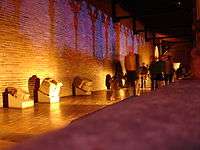Toulouse
Toulouse (/tuːˈluːz/,[5] too-LOOZ; French: [tuluz] (![]()
Toulouse | |
|---|---|
Prefecture and commune | |
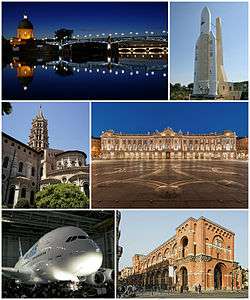 Hôpital de La Grave, Ariane 5 (Cité de l'espace), Basilica of Saint-Sernin, Place du Capitole, the very first Airbus A380, Musée des Augustins | |
.svg.png) Coat of arms | |
| Motto(s): Per Tolosa totjorn mai (Occitan for '"For Toulouse, always more"') | |
Location of Toulouse 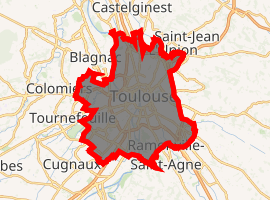
| |
 Toulouse  Toulouse | |
| Coordinates: 43°36′16″N 1°26′38″E | |
| Country | France |
| Region | Occitanie |
| Department | Haute-Garonne |
| Arrondissement | Toulouse |
| Canton | Toulouse-1, 2, 3, 4, 5, 6, 7, 8, 9, 10 and 11 |
| Intercommunality | Toulouse Métropole |
| Government | |
| • Mayor (2020–2026) | Jean-Luc Moudenc (LR) |
| Area 1 | 118.3 km2 (45.7 sq mi) |
| • Urban (2010) | 811.60 km2 (313.36 sq mi) |
| • Metro (2010) | 5,381.49 km2 (2,077.80 sq mi) |
| Population (2017-01-01)[1] | 479,553 |
| • Rank | 4th in France |
| • Density | 4,100/km2 (10,000/sq mi) |
| • Urban (Jan. 2017) | 968,638[2][3] |
| • Metro (Jan. 2017) | 1,360,829[2][4] |
| Demonym(s) | English: Toulousian French: Toulousain(e) Occitan: tolosenc(a) |
| Time zone | UTC+01:00 (CET) |
| • Summer (DST) | UTC+02:00 (CEST) |
| INSEE/Postal code | 31555 / |
| Website | www |
| 1 French Land Register data, which excludes lakes, ponds, glaciers > 1 km2 (0.386 sq mi or 247 acres) and river estuaries. | |
Toulouse is the centre of the European aerospace industry, with the headquarters of Airbus (formerly EADS), the SPOT satellite system, ATR and the Aerospace Valley. It also hosts the European headquarters of Intel and CNES's Toulouse Space Centre (CST), the largest space centre in Europe.[6] Thales Alenia Space, ATR, SAFRAN, Liebherr-Aerospace and Airbus Defence and Space also have a significant presence in Toulouse.
The University of Toulouse is one of the oldest in Europe (founded in 1229) and, with more than 103,000 students, it is the fourth-largest university campus in France, after the universities of Paris, Lyon and Lille.[7]
The air route between Toulouse–Blagnac and Paris Orly is the busiest in Europe, transporting 2.4 million passengers in 2014.[8] According to the rankings of L'Express and Challenges, Toulouse is the most dynamic French city.[9][10][11]
Founded by the Romans, the city was the capital of the Visigothic Kingdom in the 5th century and the capital of the province of Languedoc in the Late Middle Ages and early modern period (provinces were abolished during the French Revolution), making it the unofficial capital of the cultural region of Occitania (Southern France). It is now the capital of the Occitanie region, the second largest region in Metropolitan France.
Toulouse counts three UNESCO World Heritage Sites: the Canal du Midi (designated in 1996 and shared with other cities), and the Basilica of St. Sernin, the largest remaining Romanesque building in Europe[12], designated in 1998 along with the former hospital Hôtel-Dieu Saint-Jacques because of their significance to the Santiago de Compostela pilgrimage route. The city's unique architecture made of pinkish terracotta bricks has earned Toulouse the nickname La Ville Rose ("The Pink City").
Geography
Toulouse is in the south of France, north of the department of Haute-Garonne, on the axis of communication between the Mediterranean Sea and the Atlantic Ocean.
Hydrography
The city is traversed by the Canal de Brienne, the Canal du Midi and the rivers Garonne, Touch and Hers-Mort.
Climate
Toulouse has a temperate humid subtropical climate (Cfa in the Köppen climate classification). Too much precipitation during the summer months prevents the city from being classified as a Mediterranean climate zone.
| Toulouse | ||||||||||||||||||||||||||||||||||||||||||||||||||||||||||||
|---|---|---|---|---|---|---|---|---|---|---|---|---|---|---|---|---|---|---|---|---|---|---|---|---|---|---|---|---|---|---|---|---|---|---|---|---|---|---|---|---|---|---|---|---|---|---|---|---|---|---|---|---|---|---|---|---|---|---|---|---|
| Climate chart (explanation) | ||||||||||||||||||||||||||||||||||||||||||||||||||||||||||||
| ||||||||||||||||||||||||||||||||||||||||||||||||||||||||||||
| ||||||||||||||||||||||||||||||||||||||||||||||||||||||||||||
| Climate data for Toulouse (TLS), elevation: 151 m (495 ft), 1981–2010 normals, extremes 1947–present | |||||||||||||
|---|---|---|---|---|---|---|---|---|---|---|---|---|---|
| Month | Jan | Feb | Mar | Apr | May | Jun | Jul | Aug | Sep | Oct | Nov | Dec | Year |
| Record high °C (°F) | 21.2 (70.2) |
24.1 (75.4) |
27.1 (80.8) |
30.0 (86.0) |
33.4 (92.1) |
40.2 (104.4) |
40.2 (104.4) |
40.7 (105.3) |
35.3 (95.5) |
30.8 (87.4) |
24.3 (75.7) |
21.1 (70.0) |
40.7 (105.3) |
| Average high °C (°F) | 9.5 (49.1) |
11.1 (52.0) |
14.5 (58.1) |
17.0 (62.6) |
21.0 (69.8) |
25.2 (77.4) |
28.0 (82.4) |
27.9 (82.2) |
24.6 (76.3) |
19.5 (67.1) |
13.3 (55.9) |
9.9 (49.8) |
18.5 (65.3) |
| Daily mean °C (°F) | 5.9 (42.6) |
7.0 (44.6) |
9.8 (49.6) |
12.1 (53.8) |
16.0 (60.8) |
19.7 (67.5) |
22.3 (72.1) |
22.2 (72.0) |
19.0 (66.2) |
15.0 (59.0) |
9.5 (49.1) |
6.5 (43.7) |
13.8 (56.8) |
| Average low °C (°F) | 2.4 (36.3) |
3.0 (37.4) |
5.0 (41.0) |
7.1 (44.8) |
10.9 (51.6) |
14.3 (57.7) |
16.5 (61.7) |
16.5 (61.7) |
13.4 (56.1) |
10.5 (50.9) |
5.8 (42.4) |
3.2 (37.8) |
9.1 (48.4) |
| Record low °C (°F) | −18.6 (−1.5) |
−19.2 (−2.6) |
−8.4 (16.9) |
−3.0 (26.6) |
−0.8 (30.6) |
4.0 (39.2) |
7.6 (45.7) |
5.5 (41.9) |
1.9 (35.4) |
−3.0 (26.6) |
−7.5 (18.5) |
−12.0 (10.4) |
−19.2 (−2.6) |
| Average precipitation mm (inches) | 51.3 (2.02) |
41.6 (1.64) |
49.1 (1.93) |
69.6 (2.74) |
74.0 (2.91) |
60.3 (2.37) |
37.7 (1.48) |
46.8 (1.84) |
47.4 (1.87) |
57.0 (2.24) |
51.1 (2.01) |
52.4 (2.06) |
638.3 (25.13) |
| Average precipitation days (≥ 1.0 mm) | 9.2 | 7.8 | 8.6 | 9.6 | 9.9 | 7.1 | 5.0 | 6.1 | 6.5 | 8.1 | 9.2 | 8.6 | 95.7 |
| Average snowy days | 2.1 | 2.0 | 1.0 | 0.2 | 0.0 | 0.0 | 0.0 | 0.0 | 0.0 | 0.0 | 0.6 | 1.6 | 7.5 |
| Average relative humidity (%) | 87 | 82 | 77 | 76 | 76 | 72 | 68 | 71 | 74 | 81 | 85 | 88 | 78 |
| Mean monthly sunshine hours | 92.5 | 115.0 | 175.1 | 186.1 | 209.2 | 227.6 | 252.6 | 238.8 | 204.0 | 149.2 | 96.0 | 85.3 | 2,031.3 |
| Source 1: Meteo France[13][14] | |||||||||||||
| Source 2: Infoclimat.fr (relative humidity 1961–1990)[15] | |||||||||||||
| Climate data for Toulouse–Francazal, elevation: 164 m (538 ft), 1981–2010 normals, extremes 1922–present | |||||||||||||
|---|---|---|---|---|---|---|---|---|---|---|---|---|---|
| Month | Jan | Feb | Mar | Apr | May | Jun | Jul | Aug | Sep | Oct | Nov | Dec | Year |
| Record high °C (°F) | 23.3 (73.9) |
24.8 (76.6) |
28.3 (82.9) |
29.9 (85.8) |
33.9 (93.0) |
39.3 (102.7) |
40.2 (104.4) |
44.0 (111.2) |
36.0 (96.8) |
35.4 (95.7) |
27.0 (80.6) |
26.9 (80.4) |
44.0 (111.2) |
| Average high °C (°F) | 9.7 (49.5) |
11.1 (52.0) |
14.5 (58.1) |
16.9 (62.4) |
20.9 (69.6) |
25.0 (77.0) |
28.0 (82.4) |
28.0 (82.4) |
24.6 (76.3) |
19.5 (67.1) |
13.4 (56.1) |
10.1 (50.2) |
18.5 (65.3) |
| Daily mean °C (°F) | 6.1 (43.0) |
7.2 (45.0) |
9.9 (49.8) |
12.2 (54.0) |
16.1 (61.0) |
19.8 (67.6) |
22.4 (72.3) |
22.3 (72.1) |
19.1 (66.4) |
15.2 (59.4) |
9.7 (49.5) |
6.8 (44.2) |
13.9 (57.0) |
| Average low °C (°F) | 2.6 (36.7) |
3.3 (37.9) |
5.4 (41.7) |
7.4 (45.3) |
11.3 (52.3) |
14.7 (58.5) |
16.8 (62.2) |
16.7 (62.1) |
13.7 (56.7) |
10.8 (51.4) |
6.1 (43.0) |
3.4 (38.1) |
9.4 (48.9) |
| Record low °C (°F) | −19.0 (−2.2) |
−16.7 (1.9) |
−7.4 (18.7) |
−4.1 (24.6) |
0.1 (32.2) |
4.5 (40.1) |
7.0 (44.6) |
7.3 (45.1) |
0.0 (32.0) |
−2.6 (27.3) |
−8.5 (16.7) |
−13.4 (7.9) |
−19.0 (−2.2) |
| Average precipitation mm (inches) | 50.4 (1.98) |
38.5 (1.52) |
45.9 (1.81) |
65.7 (2.59) |
73.7 (2.90) |
58.0 (2.28) |
38.5 (1.52) |
42.7 (1.68) |
51.9 (2.04) |
55.4 (2.18) |
52.4 (2.06) |
52.5 (2.07) |
625.6 (24.63) |
| Average precipitation days (≥ 1.0 mm) | 8.5 | 7.1 | 8.2 | 10.0 | 9.6 | 7.0 | 4.9 | 6.2 | 6.3 | 8.2 | 8.8 | 8.7 | 93.4 |
| Average snowy days | 2.1 | 2.0 | 1.0 | 0.2 | 0.0 | 0.0 | 0.0 | 0.0 | 0.0 | 0.0 | 0.6 | 1.6 | 7.5 |
| Average relative humidity (%) | 87 | 82 | 77 | 76 | 76 | 72 | 68 | 71 | 74 | 81 | 85 | 88 | 78 |
| Mean monthly sunshine hours | 93.1 | 116.6 | 173.6 | 186.7 | 207.5 | 224.8 | 246.8 | 234.9 | 202.5 | 147.9 | 94.9 | 85.4 | 2,014.5 |
| Source: Meteo France[16] | |||||||||||||
History
Early history
The Garonne Valley was a central point for trade between the Pyrenees, the Mediterranean and the Atlantic since at least the Iron Age. The historical name of the city, Tolosa (Τολῶσσα in Greek, and of its inhabitants, the Tolosates, first recorded in the 2nd century BC), it is of unknown meaning or origin, possibly from Aquitanian or Iberian,[17] but it has also been connected to the name of the Gaulish Volcae Tectosages.[18]
Tolosa enters the historical period in the 2nd century BC, when it became a Roman military outpost. After the conquest of Gaul, it was developed as a Roman city of Gallia Narbonensis. In the 5th century, Tolosa fell to the Visigothic kingdom and became one of its major cities, in the early 6th century even serving as its capital, before it fell to the Franks under Clovis in 507 (Battle of Vouillé). From that time, Toulouse was the capital of Aquitaine within the Frankish realm.[19]
In 721, Duke Odo of Aquitaine defeated an invading Umayyad Muslim army at the Battle of Toulouse. Many Arab chroniclers consider that Odo's victory was the real stop to Muslim expansion into Christian Europe, incursions of the following years being simple raids without real will of conquest (including the one that ended with Charles Martel's victory at the Battle of Tours, also called the Battle of Poitiers).[20]
The Frankish conquest of Septimania followed in the 750s, and a quasi-independent County of Toulouse emerged within the Carolingian sub-kingdom of Aquitaine by the late 8th century. The Battle of Toulouse of 844, pitting Charles the Bald against Pepin II of Aquitaine, was key in the Carolingian Civil War.
County of Toulouse
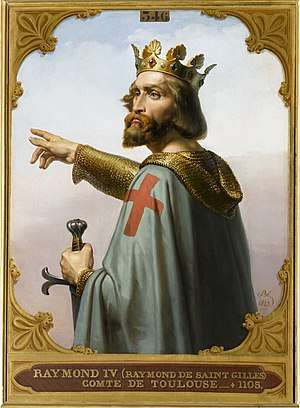
The town became the capital of the County of Toulouse during the Carolingian era.
In 1096, Raymond IV, Count of Toulouse, left with his army at the call of the Pope to join the First Crusade, of which he was one of the main leaders.
At the beginning of the thirteenth century the county of Toulouse was taken in another crusade, of which it was the target this time. The reason for this was the development of Catharism in the south of France, which the Pope wanted to eradicate by all possible means. This struggle took on several aspects, going beyond the military crusade, such as the creation of an original and militant Gothic architecture: the Southern French Gothic.
In 1215, the Dominican Order was founded in Toulouse by Saint Dominic in the context of struggle against the Cathar heresy.
In the Treaty of Paris of 1229, Toulouse formally submitted to the crown of France. The county's sole heiress Joan was engaged to Alphonse, Count of Poitiers, a younger brother of Louis IX of France. The marriage became legal in 1241, but it remained childless and so after Joan's death, the county fell to the Crown of France by inheritance.
Also in 1229, University of Toulouse was established after the Parisian model, intended as a means to dissolve the heretic movement.
Various monastic orders, like the congregation of the order of frères prêcheurs, were started. They found home in Les Jacobins. In parallel, a long period of inquisition began inside the Toulouse walls. The fear of repression forced the leading figures to exile or to convert themselves. The inquisition lasted nearly 400 years, making Toulouse its capital.
Kingdom of France
In 1271, Toulouse was incorporated into the kingdom of France and declared a "royal city". In 1323 the Consistori del Gay Saber was created in Toulouse to preserve the lyric art of the troubadours by organizing a poetry contest; and Toulouse became the centre of Occitan literary culture for the next hundred years. The Consistori del Gay Saber is considered to be the oldest literary society in Europe, at the origin of the most sophisticated treatise on grammar and rhetoric of the Middle Ages, and in 1694 it was transformed into the Royal Academy of the Floral Games (Académie des Jeux Floraux), still active today, by king Louis XIV.
The 14th century brought a pogrom against Toulouse's Jewish population by Crusaders in 1320,[21] the Black Death in 1348, then the Hundred Years' War. Despite strong immigration, the population lost 10,000 inhabitants in 70 years. By 1405 Toulouse had only 19,000 people.[22]
The situation improved in the 15th century.[23] Charles VII established the second parliament of France after that of Paris. Reinforcing its place as an administrative center, the city grew richer, participating in the trade of Bordeaux wine with England, as well as cereals and textiles. A major source of income was the production and export of pastel, a blue dye made from woad.[24] The fortune generated by this international trade was at the origin of several of Toulouse's superb Renaissance mansions.
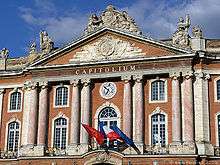
French Empire
The Battle of Toulouse (1814) was one of the final battles of the Napoleonic Wars, four days after Napoleon's surrender of the French Empire to the nations of the Sixth Coalition. Toulouse, the regional capital, proved stoutly defended by Marshal Soult.
Population
| Historical population[2][3][4] | ||||
|---|---|---|---|---|
| Urban Area | Metropolitan Area | |||
| 1695 | ||||
| 1750 | ||||
| 1790 | ||||
| 1801 | ||||
| 1831 | ||||
| 1851 | ||||
| 1872 | ||||
| 1911 | ||||
| 1936 | ||||
| 1946 | ||||
| 1954 | ||||
| 1962 | ||||
| 1968 | ||||
| 1975 | ||||
| 1982 | ||||
| 1990 | ||||
| 1999 | ||||
| 2007 | ||||
| 2012 | ||||
| 2017 | ||||
The population of the city proper (French: commune) was 479,553 at the January 2017 census, with 1,360,829 inhabitants in the metropolitan area (within the 2010 borders of the metropolitan area), up from 1,187,686 at the January 2007 census (within the same 2010 borders of the metropolitan area).[2][4] Thus, the metropolitan area registered a population growth rate of +1.4% per year between 2007 and 2017, the highest growth rate of any French metropolitan area larger than 500,000 inhabitants, although it is slightly lower than the growth rate registered between the 1999 and 2007 censuses.
Toulouse is the fourth largest city in France, after Paris, Marseille and Lyon, and the fourth-largest metropolitan area after Paris, Lyon, and Marseille.
Fueled by booming aerospace and high-tech industries, population growth of +1.49% a year in the metropolitan area in the 1990s (compared with +0.37% for metropolitan France), and a record +1.87% a year in the early 2000s (+0.68% for metropolitan France), which is the highest population growth of any French metropolitan area larger than 500,000 inhabitants, means the Toulouse metropolitan area overtook Lille as the fourth-largest metropolitan area of France at the 2006 census.
A local Jewish group estimates there are about 2,500 Jewish families in Toulouse. A Muslim association has estimated there are some 35,000 Muslims in town.[25]
Government and politics
Toulouse Métropole
The Community of Agglomeration of Greater Toulouse (Communauté d'agglomération du Grand Toulouse) was created in 2001 to better coordinate transport, infrastructure and economic policies between the city of Toulouse and its immediate independent suburbs. It succeeds a previous district which had been created in 1992 with fewer powers than the current council. It combines the city of Toulouse and 24 independent communes, covering an area of 380 km2 (147 sq mi), totalling a population of 583,229 inhabitants (as of 1999 census), 67% of whom live in the city of Toulouse proper. As of February 2004 estimate, the total population of the Community of Agglomeration of Greater Toulouse was 651,209 inhabitants, 65.5% of whom live in the city of Toulouse. Due to local political feuds, the Community of Agglomeration only hosts 61% of the population of the metropolitan area, the other independent suburbs having refused to join in. Since 2009, the Community of agglomeration has become an urban community (in French: communauté urbaine). This has become a métropole in 2015, spanning 37 communes.[26]
Local politics


One of the major political figures in Toulouse was Dominique Baudis, the mayor of Toulouse between 1983 and 2001, member of the centrist UDF. First known as a journalist famous for his coverage of the war in Lebanon, 36-year-old Dominique Baudis succeeded his father Pierre Baudis in 1983 as mayor of Toulouse. (Pierre Baudis was mayor from 1971 to 1983.)
Baudis tried to strengthen the international role of Toulouse (such as its Airbus operations), as well as revive the cultural heritage of the city. The Occitan cross, flag of Languedoc and symbol of the counts of Toulouse, was chosen as the new flag of the city, instead of the traditional coat of arms of Toulouse (which included the fleur de lis of the French monarchy). Many cultural institutions were created, in order to attract foreign expatriates and emphasise the city's past. For example, monuments dating from the time of the counts of Toulouse were restored, the city's symphonic concert hall (Halle aux Grains) was refurbished, a city theater was built, a Museum of Modern Art was founded, the Bemberg Foundation (European paintings and bronzes from the Renaissance to the 20th century) was established, a huge pop music concert venue (Zénith, the largest in France outside Paris) was built, the space museum and educational park Cité de l'Espace was founded, etc.
To deal with growth, major housing and transportation projects were launched. Line A of the underground was opened in 1993, and line B opened in 2007. The creation of a system of underground car parking structures in Toulouse city centre was sharply criticised by the Green Party.[27]
In 2000, Dominique Baudis was at the zenith of his popularity, with approval rates of 85%. He announced that he would not run for a fourth (6-year) term in 2001. He explained that with 3 terms he was already the longest-serving mayor of Toulouse since the French Revolution; he felt that change would be good for the city, and that the number of terms should be limited. He endorsed Philippe Douste-Blazy, then UDF mayor of Lourdes as his successor. Baudis has since been appointed president of the CSA (Conseil supérieur de l'audiovisuel) in Paris, the French equivalent of the American FCC.
Philippe Douste-Blazy narrowly won in the 2001 elections, which saw the left making its best showing in decades. Douste-Blazy had to deal with a reinvigorated political opposition, as well as with the dramatic explosion of the AZF plant in late 2001.
In March 2004, he entered the national government, and left Toulouse in the hands of his second-in-command Jean-Luc Moudenc, elected mayor by the municipal council. In March 2008, Moudenc was defeated by the Socialist Party's candidate Pierre Cohen.
At the next elections in 2014 Moudenc defeated Cohen in a rematch to re-take the job with more than 52% of the votes.
Mayors
| Mayor | Term start | Term end | Party | |
|---|---|---|---|---|
| Raymond Badiou | 1944 | September 1958 | SFIO | |
| G. Carrère | September 1958 | 16 October 1958 | SFIO | |
| Louis Bazerque | 16 October 1958 | 1971 | SFIO | |
| Pierre Baudis | March 1971 | March 1983 | UDF | |
| Dominique Baudis | March 1983 | 23 January 2001 | UDF | |
| Guy Hersant | 23 January 2001 | 23 March 2001 | UDF | |
| Philippe Douste-Blazy | 23 March 2001 | 30 April 2004 | UDF | |
| Françoise de Veyrinas | 30 April 2004 | 6 May 2004 | UMP | |
| Jean-Luc Moudenc | 6 May 2004 | 17 March 2008 | UMP | |
| Pierre Cohen | 17 March 2008 | 4 April 2014 | PS | |
| Jean-Luc Moudenc | 4 April 2014 | incumbent | UMP | |
Sights
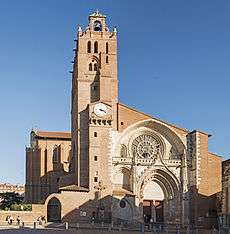
Religious buildings
Toulouse has many interesting churches, but three of them are of remarkable architectural and historical interest.
Saint-Sernin Basilica, part of the Way of Saint James UNESCO World Heritage Site, is the largest remaining Romanesque church in Europe. With more than two hundred relics (including six apostles), most of them donated by Charlemagne to the sanctuary that preceded the present church, Saint-Sernin makes Toulouse the second city in Europe after Rome for the number of relics. The church was built at the end of the 11th century and at the beginning of the 12th century to welcome the crowds of pilgrims, its double-sided aisles and the ambulatory surrounding the apse make it the archetype of the great pilgrimage church, where pilgrims could make the circuit around the church and were able to stop for meditation and prayer at the apsidal chapels of the transept and the radiating chapels of the choir.
Cathedral of Saint Stephen is the seat of the Roman Catholic Archdiocese of Toulouse. Its construction, which was mainly done at the beginning and then at the end of the 13th century, reflects the history of this decisive century which saw the city lose its independence to become a French city. The single nave is the very first example of Southern French Gothic, at 19 metres wide it probably was at its completion the widest in Western Europe (1210-1220). The higher choir that adjoins it was built in the Gothic style of northern France shortly after the city became part of the Crown of France in 1271.
The convent of the Jacobins (late 13th century / early 14th century) is considered to be, together with the Albi Cathedral, the pinnacle of Southern French Gothic architecture. Like all Southern French Gothic churches it has a deliberately austere exterior, but it reveals the beauty of its architecture on the inside with an alignment of columns that are said to be the highest in Gothic architecture (28 metres high). The masterpiece of this church is the column that closes the choir (1275-1292), its palm tree shape was a hundred years ahead of the flamboyant gothic fan vaults. Because he thought it was the most beautiful Dominican church in Europe, and perhaps also to compensate Toulouse, the birthplace of the Dominican order, for not having obtained the relics of Saint Dominic kept in Bologna, Pope Urban V made the church of the Jacobins the burial place of the Dominican friar Saint Thomas Aquinas, one of the most famous philosophers and theologians of the Middle Ages.
Civilian buildings
.jpg)
The Capitole de Toulouse (mainly 18th century), houses the Hôtel de Ville (city hall) and the Théâtre du Capitole (opera house). It is located on the Place du Capitole, a large 19th century square that has the size of a royal square (place royale). The large neo-classical facade of the 18th century (1750-1760) hides elements from various periods: the Henri IV courtyard of the early 17th century with a remarkable Renaissance portal; a 16th-century tower, called «the keep» (le donjon), which housed the archives of the Capitouls; vast rooms and galleries with walls painted to the glory of the history of Toulouse (late 19th century)...
Toulouse has also preserved a rich civil architectural heritage from the medieval and Renaissance periods. Forty or so Gothic and Renaissance stair towers still dot the city, mostly hidden in inner courtyards. More than two hundred mansions (called hôtels particuliers) or remains of mansions give an account of the evolution of civil architecture since the 12th century. The most remarkable are those of the Renaissance, a period which constitutes a golden age for Toulouse. Among these are the Hôtel d'Assézat, the Hôtel de Bernuy, the Hôtel du Vieux-Raisin, the Hôtel de Bagis...
Some other sights
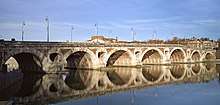
The banks of the Garonne river offer an interesting urban panorama of the city. Red brick dykes from the 18th century enclose the river which is subject to violent floods. The only bridge to have withstood the floods of the past is the Pont-Neuf, it took almost a century to build it as the project was so ambitious (1545-1632). Further downstream, the Bazacle is a ford across the Garonne river, in the 12th century the Bazacle Milling Company was the first recorded European joint-stock company. On the left bank of the river, historically a flood-prone bank, stand two former hospitals whose origins date back to the 12th century: the Hôtel-Dieu Saint-Jacques and the Hôpital de La Grave. This is how the plague victims and other sick people were kept away from the city by the river.
Built at the end of the 17th century, the Canal du Midi bypasses the city centre and has linked Toulouse to the Mediterranean Sea ever since. Its 240 kilometres were inscribed as a UNESCO World Heritage Site in 1996.
The Jardin des Plantes is a large park spanning several blocks, including the museum of Natural History, cafés, activities for children and a botanical garden (early 19th century).
The Cité de l'espace (Space City) is a theme park of space exploration.
Gallery
- Sights and monuments of Toulouse
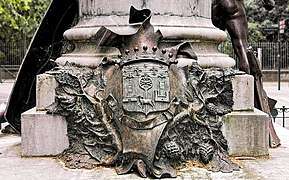 Coats of arms of Toulouse: Saint-Sernin church and Comtal castle frame a paschal lamb bearing the Toulouse cross
Coats of arms of Toulouse: Saint-Sernin church and Comtal castle frame a paschal lamb bearing the Toulouse cross Saint-Sernin basilica (11th–13th c.)
Saint-Sernin basilica (11th–13th c.)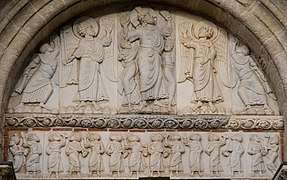 Romanesque tympanum of Saint-Sernin basilica (late 11th c. or early 12th c.)
Romanesque tympanum of Saint-Sernin basilica (late 11th c. or early 12th c.)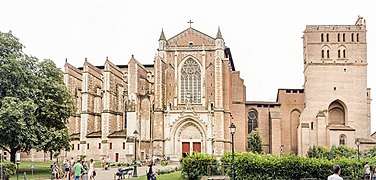 Saint Stephen cathedral (13th–17th c.)
Saint Stephen cathedral (13th–17th c.)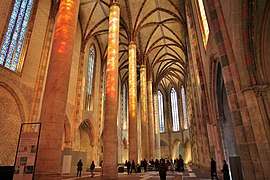 Church of the Jacobins (13th c.)
Church of the Jacobins (13th c.)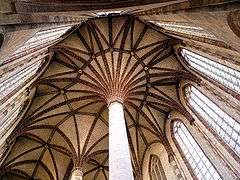 Church of the Jacobins "palm tree" vault (13th c.)
Church of the Jacobins "palm tree" vault (13th c.) Church of the Jacobins bell tower (13th c.) and cloister (14th c.)
Church of the Jacobins bell tower (13th c.) and cloister (14th c.)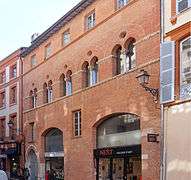 Romano-gothic house (14th c.)
Romano-gothic house (14th c.) Musée des Augustins former convent (14th c.) housing a fine arts museum
Musée des Augustins former convent (14th c.) housing a fine arts museum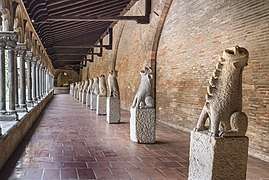 Musée des Augustins cloister (14th c.) with display of gargoyles salvaged from demolished churches
Musée des Augustins cloister (14th c.) with display of gargoyles salvaged from demolished churches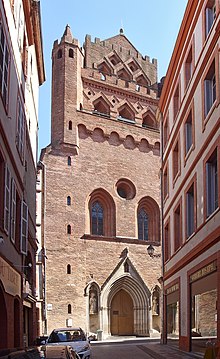 Church of Notre-Dame du Taur: clocher-mur facade (14th c.)
Church of Notre-Dame du Taur: clocher-mur facade (14th c.)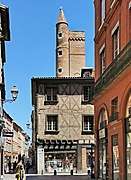 Serta tower (15th–16th c.)
Serta tower (15th–16th c.)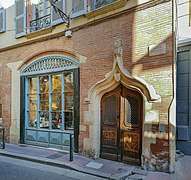 Hôtel Delfau (15th c.)
Hôtel Delfau (15th c.)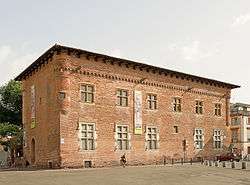 Saint-Raymond museum, former college of the university (1523)
Saint-Raymond museum, former college of the university (1523) Former tower of the Capitouls (1525)
Former tower of the Capitouls (1525)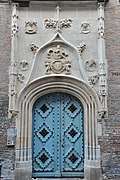 Gothic and Renaissance portal of the hôtel de Bernuy (16th c.)
Gothic and Renaissance portal of the hôtel de Bernuy (16th c.).jpg) Renaissance portal of the hôtel d'Assézat (16th c.)
Renaissance portal of the hôtel d'Assézat (16th c.) Renaissance portal of the hôtel de Molinier (16th c.)
Renaissance portal of the hôtel de Molinier (16th c.)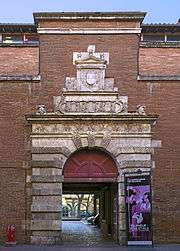 Renaissance portal (16th c.) of a college of the University
Renaissance portal (16th c.) of a college of the University Renaissance Portal of the Dalbade Church (16th c.)
Renaissance Portal of the Dalbade Church (16th c.)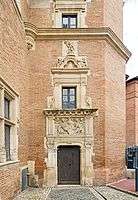 Renaissance door of the Hôtel Dahus (16th c.)
Renaissance door of the Hôtel Dahus (16th c.)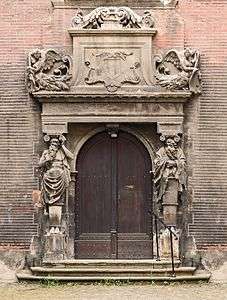 Hôtel de Bagis' Renaissance door (16th or 17th c.)
Hôtel de Bagis' Renaissance door (16th or 17th c.)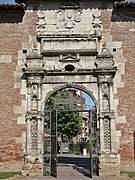 Renaissance portal of former Capitole at Jardin des Plantes (16th c.)
Renaissance portal of former Capitole at Jardin des Plantes (16th c.)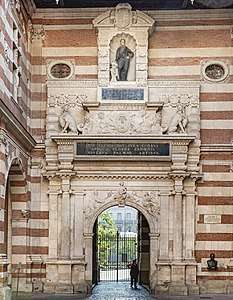 Renaissance portal of the Capitole in the courtyard (16th-17th c.)
Renaissance portal of the Capitole in the courtyard (16th-17th c.) Renaissance portal of the former Jesuit college (1605)
Renaissance portal of the former Jesuit college (1605) Renaissance courtyard of the Hôtel d'Assézat (16th c.)
Renaissance courtyard of the Hôtel d'Assézat (16th c.)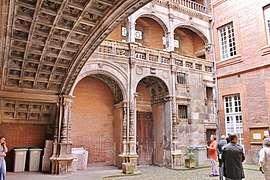 Renaissance courtyard of the Hôtel de Bernuy (16th c.)
Renaissance courtyard of the Hôtel de Bernuy (16th c.).jpg) Tower of the Hôtel de Bernuy (16th c.)
Tower of the Hôtel de Bernuy (16th c.)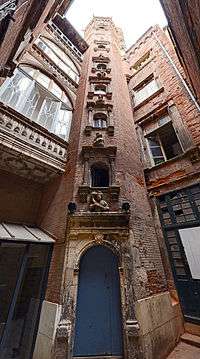 Tower of the Hôtel de Brucelles (16th c.)
Tower of the Hôtel de Brucelles (16th c.)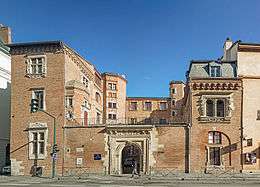 Hôtel du Vieux-Raisin (16th c.)
Hôtel du Vieux-Raisin (16th c.)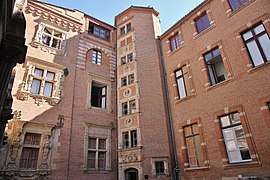 Renaissance courtyard of the Hôtel du Vieux-Raisin (16th c.)
Renaissance courtyard of the Hôtel du Vieux-Raisin (16th c.)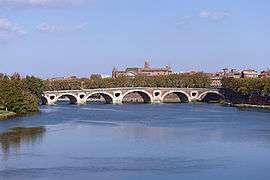 Pont neuf (16th–17th c.)
Pont neuf (16th–17th c.) Hôtel Comère (17th c.)
Hôtel Comère (17th c.).jpg) Hôtel de Resseguier (17th c.)
Hôtel de Resseguier (17th c.).jpg) Hôtel de Bonfontan (18th c.)
Hôtel de Bonfontan (18th c.)- Hôtel d'Espie (18th c.)
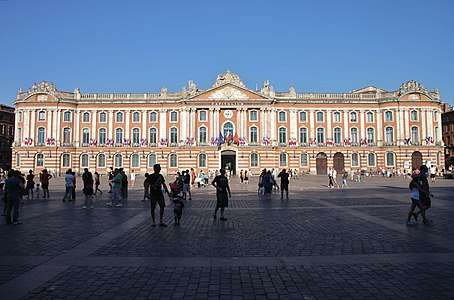 Capitole – city hall (18th c.)
Capitole – city hall (18th c.)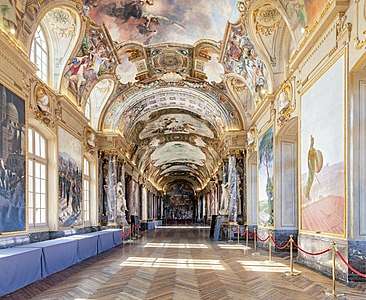 The Hall of Illustrious in the Capitole
The Hall of Illustrious in the Capitole.jpg) Capitole square (19th c.)
Capitole square (19th c.) Immeuble des Cariatides, terracotta façade by fr:Auguste Virebent (19th c.)
Immeuble des Cariatides, terracotta façade by fr:Auguste Virebent (19th c.).jpg) Lamothe house, terracotta façade (19th c.)
Lamothe house, terracotta façade (19th c.) Halle aux Grains concert hall (19th c.) fr:Halle aux Grains de Toulouse
Halle aux Grains concert hall (19th c.) fr:Halle aux Grains de Toulouse.jpg) Hôtel-Dieu Saint-Jacques former hospital (12th–19th c.)
Hôtel-Dieu Saint-Jacques former hospital (12th–19th c.)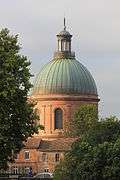 La Grave former hospital (12th–19th c.)
La Grave former hospital (12th–19th c.)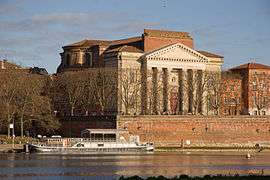 Notre-Dame de la Daurade basilica
Notre-Dame de la Daurade basilica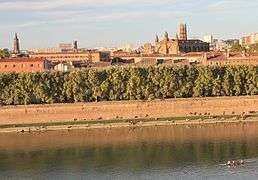 Banks of the Garonne river
Banks of the Garonne river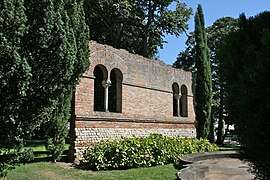 Romanesque wall in the park of the Jardin des Plantes
Romanesque wall in the park of the Jardin des Plantes.jpg) Park of the Grand Rond in central Toulouse
Park of the Grand Rond in central Toulouse
Economy
The main industries are aeronautics, space, electronics, information technology and biotechnology. Toulouse hosts the Airbus headquarters and assembly-lines of Airbus A320, A330, A350 and A380. (A320 lines also exist in Hamburg, Germany, Tianjin, China, and Mobile, Alabama, USA.) Airbus has its head office in Blagnac, near Toulouse.[28][29] Airbus's France division has its main office in Toulouse.[29] Toulouse also hosts the headquarters of ATR, Sigfox, one of the two headquarters of Liebherr Aerospace and Groupe Latécoère. The Concorde supersonic aircraft was also constructed in Toulouse.
Education

Toulouse has the fourth-largest student population in France after Paris, Lyon and Lille with 103,000 students (2012).[30]
Colleges and universities
.jpg)

The University of Toulouse (Université de Toulouse), established in 1229, is located here (now split into three separate universities). Like the universities in Oxford and Paris, the University of Toulouse was established at a time when Europeans were starting to translate the writings of Arabs of Andalus and Greek philosophers. These writings challenged European ideology—inspiring scientific discoveries and advances in the arts—as society began seeing itself in a new way. These colleges were supported by the Church, in hopes of reconciling Greek philosophy and Christian theology.
- Catholic University of Toulouse
- Université Toulouse I, Toulouse School of Economics, Toulouse School of Management and Institut d'études politiques de Toulouse
- University of Toulouse-Jean Jaurès (Formerly University of Toulouse II – Le Mirail)
- Université Paul Sabatier (Toulouse III)
Toulouse is also the home of Toulouse Business School (TBS), Toulouse School of Economics (TSE), the Institut supérieur européen de gestion group (ISEG Group), the Institut supérieur européen de formation par l'action (ISEFAC), E-Artsup and several engineering schools:
- ICAM Toulouse (Institut catholique d'arts et métiers)
- INSA Toulouse
- ISAE SUPAERO (Institut supérieur de l'aéronautique et de l'espace)
- ENAC (École Nationale de l'Aviation Civile)
- INP ENSEEIHT (École Nationale Supérieure d'Électronique, d'Électrotechnique, d'Informatique, d'Hydraulique et des Télécommunications)
- ENSFEA (École nationale supérieure de formation de l’enseignement agricole)
- INP ENSIACET (École nationale supérieure d'ingénieurs en art chimique et technologique)
- INP ENSAT ('École Nationale Supérieure Agronomique de Toulouse)
- INP ENM (École Nationale de la Météorologie)
- EPITA (École pour l'informatique et les techniques avancées)
- EPITECH (École pour l'informatique et les nouvelles technologies or European Institute of Information Technology)
- IPSA (Institut Polytechnique des Sciences Avancées)
- EIPurpan (École d'ingénieurs de Purpan)
Primary and secondary schools
The most well known high schools in Toulouse are Lycée Pierre-de-Fermat and Lycée Saint-Sernin.
International schools serving area expatriates are in nearby Colomiers:
- International School of Toulouse
- Deutsche Schule Toulouse (German school)
Transport

Train
The main railway station, with regional and national services, is Toulouse-Matabiau.
Metro
In addition to an extensive bus system, the Toulouse Metro is a VAL (Véhicule Automatique Léger) metro system made up of driverless (automatic) rubber-tired trains. Line A runs for 12.5 km (7.8 mi) from Balma-Gramont in the north-east to Basso Cambo in the south-west. Line B, which opened in June 2007, serves 20 stations north to south and intersects line A at Jean Jaurès.
Line C has existed since line A was completed. It is not VAL but an urban railway line operated by SNCF. It connects to line A at Arènes. Two other stations located in Toulouse are also served by line C. Lardenne, formerly named "Gare des Capelles", changed its name in September 2003 when line C opened.[31] Le TOEC station opened on 1 September 2003 with the creation of line C, allowing an urban train service in Toulouse and close western suburbs.[31]
Similarly, Line D runs south from Toulouse Matabiau to Muret.
Tramway
The tramway line T1 (operating since December 2010), runs from Beauzelle to Toulouse passing through Blagnac. All urban bus, metro and tram services are operated by Tisséo. Tramway line T2 is a branch of the first line serving notably Toulouse Blagnac airport.
Bicycle
In 2007, a citywide bicycle rental scheme called VélôToulouse was introduced,[32] with bicycles available from automated stations for a daily, weekly, monthly or yearly subscription.
Canal
The Canal du Midi begins in Toulouse and runs up to Sète.
Toulouse public transportation statistics
The average amount of time people spend commuting with public transit in Toulouse, for example to and from work, on a weekday is 44 min. 9.1% of public transit riders, ride for more than 2 hours every day. The average amount of time people wait at a stop or station for public transit is 9 min, while 10.4% of riders wait for over 20 minutes on average every day. The average distance people usually ride in a single trip with public transit is 7 km, while 8% travel for over 12 km in a single direction.[33]
Communications
Toulouse is the home of Bonhoure Radio Tower, a 61-metre high lattice tower used for FM and TV transmission.[34] In 2001 a large (100 km) optical fiber (symmetric 360Gbit/s) network named Infrastructure Métropolitaine de Télécommunications was deployed around the city and suburbs.[35]
Culture
The Théâtre du Capitole is the home of opera and ballet; there has been a theatre on the site since 1736.[36] The Orchestre National du Capitole, long associated with Michel Plasson, plays at the Halle aux Grains.[37]
Le Château d'Eau,[38] an old 19th-century water-tower, was converted as a gallery in 1974 by Jean Dieuzaide, a French photographer from Toulouse and is now one of the oldest public places dedicated to photography in the world. Toulouse's art museums include the Musée des Augustins, the Musée des Abattoirs, the Musée Georges Labit, and the Fondation Bemberg in the Hôtel d'Assézat. The Musée Saint-Raymond is devoted to Antiquity and the Muséum de Toulouse to natural history.
Toulouse is the seat of the Académie des Jeux Floraux, the equivalent of the French Academy for the Occitan-speaking regions of southern France, making Toulouse the unofficial capital of Occitan culture. The traditional Cross of Toulouse (from Provence, under the name of cross of Provence), emblem of the County of Toulouse and commonly widespread around all of Occitania during the Middle Ages is the symbol of the city and of the newly founded Midi-Pyrénées région, as well as a popular Occitan symbol.
The city's gastronomic specialties include the Saucisse de Toulouse, a type of sausage, cassoulet Toulousain, a bean and pork stew, and garbure, a cabbage soup with poultry. Also, foie gras, the liver of an overfed duck or goose, is a delicacy commonly made in the Midi-Pyrénées.[39]
Sport
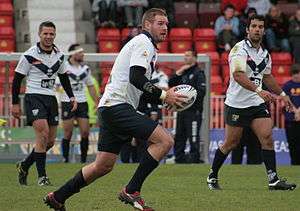
Stade Toulousain of the Top 14 is one of the most successful rugby union clubs in all of Europe, having been crowned European champions four times and French champions twenty times.[40][41]
Toulouse Olympique represents the city in rugby league, playing in the English/European 2nd tier Championship from 2017.
The city also has a professional football team, Toulouse FC, who play in Ligue 2, the second division of football in France, and who won the 1957 Coupe de France Final. The club play at the Stadium Municipal, which was a venue during the 1998 FIFA World Cup and 2007 Rugby World Cup, as well as hosting important club rugby games and several Rugby League World Cups. Toulouse was also a host of EuroBasket 1999.
Notable people

Several notable Toulousains have been scientists, such as Jean Dausset, 1980 winner of the Nobel Prize in Physiology or Medicine; 17th-century mathematician Pierre de Fermat, who spent his life in Toulouse, where he wrote Fermat's Last Theorem and was a lawyer in the city's Parlement; Paul Sabatier, 1912 winner of the Nobel Prize in Chemistry; Albert Fert,[42] 2007 winner of the Nobel Prize in Physics who grew up in Toulouse where he attended the Lycée Pierre-de-Fermat and Jean Tirole, owner of the 2014 Nobel Prize in Economic Sciences, chairman and founder of the Toulouse School of Economics along with Jean-Jacques Laffont.
Musically, Toulouse is one of the two controversial, disputed birthplaces of Carlos Gardel (the other being Tacuarembo, Uruguay), probably the most prominent figure in the history of the tango. The city's most renowned songwriter is Claude Nougaro. The composer and organist Georges Guiraud (1868–1928) was born in Toulouse.
Concerning arts, Toulouse is the birthplace of Impressionist painter Henri Martin as well as sculptors Alexandre Falguière and Antonin Mercié. Moreover, Jean-Auguste-Dominique Ingres and Antoine Bourdelle were trained at the Toulouse fine arts school. Post Impressionist painter Henri de Toulouse-Lautrec's (1864-1901) father was Count Alphonse Charles de Toulouse-Lautrec Monfa (1838-1913) and was part of an aristocratic family of Counts of Toulouse, Odet de Foix, Vimcomte de Lautrec and the Viscounts of Montfa. French graffiti artist Cyril Kongo was born in Toulouse in 1969.
Raymond IV, Count of Toulouse, one of the leaders of the First Crusade, was born in Toulouse. Aviation pioneer Clément Ader and psychiatrist Jean-Étienne Dominique Esquirol were also natives.
International relations
Twin towns and sister cities
Toulouse is twinned with:[43]
Other cooperations
Toulouse also has accords of cooperation with the following towns:[44]

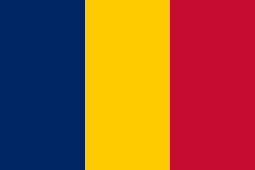



See also
- 138 Tolosa, an asteroid
- Roman Catholic Archdiocese of Toulouse
- André Abbal
- Listing of the works of Alexandre Falguière
- The works of Antonin Mercié
- List of the mayors of Toulouse
References
Citations
- "Populations légales 2017". INSEE. Retrieved 6 January 2020.
- "Populations légales communales depuis 1968". INSEE. Retrieved 8 June 2020.
- "Base des unités urbaines 2010 au 1ᵉʳ janvier 2020". INSEE. Retrieved 8 June 2020.
- "Base des aires urbaines 2010 au 1ᵉʳ janvier 2020". INSEE. Retrieved 8 June 2020.
- "Toulouse". Collins English Dictionary. HarperCollins. Retrieved 24 September 2014.
- CNES. "Ademe.fr" (PDF) (in French). Archived from the original (PDF) on 29 June 2007. Retrieved 30 May 2007.
- Lefebvre, Olivier (2014). Atlas régional : effectifs d'étudiants en 2012-2013 (PDF). Paris: Ministère de l'Education nationale, de l'Enseignement supérieur et de la Recherche.
- Infographic / Air transport in Europe Aertec, Eurostat
- Palmarès des villes les plus dynamiques : la revanche de la province L'Express
- Les villes les plus dynamiques de France Archived 23 September 2015 at the Wayback Machine Challenges
- Toulouse, métropole la plus dynamique La Dépêche du Midi
- Toulouse's Saint Sernin, Largest Romanesque Church in Europe Europe Close
- "Climatological Information for Toulouse, France". Meteo France. 7 August 2019.
- "TOULOUSE–BLAGNAC (31)" (PDF). Fiche Climatologique: Statistiques 1981–2010 et records (in French). Meteo France. Retrieved 7 August 2019.
- "Normes et records 1961–1990: Toulouse-Blagnac (31) – altitude 151m" (in French). Infoclimat. Archived from the original on 4 March 2016. Retrieved 7 August 2019.
- "TOULOUSE–FRANCAZAL (31)" (PDF). Fiche Climatologique: Statistiques 1981–2010 et records (in French). Meteo France. Retrieved 7 August 2019.
- Albert Dauzat et Charles Rostaing, Dictionnaire étymologique des noms de lieux en France, 2nd ed., Librairie Guénégaud 1978.
- Le Nom de Toulouse de Pierre Moret, 1996, Université Toulouse le Mirail – Toulouse II, p. 11; Histoire de Toulouse, 1974, p. 11.
- The Capetians: Kings of France 987-1328, p. 59, Jim Bradbury,2007
- https://gallica.bnf.fr/ark:/12148/bpt6k415420b/f39.
- " "Goldberg, Jeffrey. "Is it Time for the Jews to Leave Europe?" The Atlantic. April 2015". Retrieved 21 March 2015.
- Biraben, Jean-Noël. La Population de Toulouse au XIVe et au XVe siècles [Pierre Wolff, Les Estimes toulousaines du XIVe et XVe siècles]. Journal des savants, 1964, p. 300.
- Brumont, Francis. La commercialisation du pastel toulousain (1350–1600). Privat presse, 1994, p. 27.
- "terredepastel.com". terredepastel.com. Retrieved 3 May 2015.
- Irish, John. "Killings sour good life for high-flying Toulouse". Reuters.com. Retrieved 1 October 2013.
- "Décret n° 2014-1078 du 22 septembre 2014 portant création de la métropole dénommée « Toulouse Métropole » | Legifrance". Retrieved 30 June 2017.
- "Toulouse politics information". Bonjourlafrance.com. Retrieved 1 October 2013.
- "Airbus A380 lands after making aviation history." USA Today. 27 April 2005. Updated 28 April 2005. Retrieved 12 February 2010.
- "Contacts Archived 10 January 2010 at the Wayback Machine." Airbus. Retrieved 12 February 2010.
- "Toulouse, France travel guide - Travel S Helper". TravelsHelper. Retrieved 20 February 2017.
- "Le RER toulousain entre en gares". ladepeche.fr. Retrieved 6 February 2016.
- "VélôToulouse arrive..." La Dépêche du Midi (in French). Toulouse. 11 November 2007. Retrieved 27 March 2017.
- "Toulouse Public Transportation Statistics". Global Public Transit Index by Moovit. Retrieved 19 June 2017.

- Bonhoure Transmission Tower at Structurae
- "Garonne-networks.com". Garonne-networks.com. Archived from the original on 8 February 2011. Retrieved 14 March 2011.
- "L'univers du Théâtre". Theatre-du-capitole.fr. Archived from the original on 17 February 2013. Retrieved 14 March 2011.
- "Orchestre National du Capitole de Toulouse". Onct.mairie-toulouse.fr. Retrieved 14 March 2011.
- "'''''Le Château d'Eau''''' Official website" (in French). Galeriechateaudeau.org. Retrieved 1 October 2013.
- "The production regions". foiegras-factsandtruth.com. Retrieved 4 February 2019.
- "Europe's Top Rugby Clubs – For Dummies". Dummies.com. 4 January 2010. Retrieved 1 October 2013.
- "ERC : Classement Européen". Ercrugby.com. 21 September 2010. Retrieved 1 October 2013.
- "Albert Fert retrouve son Toulouse". La Dépêche du Midi. Retrieved 23 May 2008.
- "Les villes jumelées" (in French). Toulouse, France: Mairie de Toulouse. Retrieved 5 July 2015.
- "Accords de coopération" (in French). Toulouse, France: Mairie de Toulouse. Retrieved 5 July 2015.
Sources
- Le Stang, Anne (2006). Histoire de Toulouse illustrée (in French). leperegrinateurediteur.com. ISBN 2-910352-44-7.
- Kerrison, Helen & Jeremy (2008). The Practical Guide to Toulouse. leperegrinateurediteur.com. ISBN 2-910352-46-3.
External links
| Wikimedia Commons has media related to Toulouse. |
| Wikivoyage has a travel guide for Toulouse. |
- Toulouse tourist office
- ToulouseCity.com (in French)
- Toulouse city guide – About-France.com
- Toulouse: pink, violets, red and black – Official French website
- Official site (in French)
